#moravian tradition
Text
Rakvice🇨🇿
Some beautiful Moravian dresses/costumes from Rakvice, a village/municipality in the South East of Czechia🇨🇿.
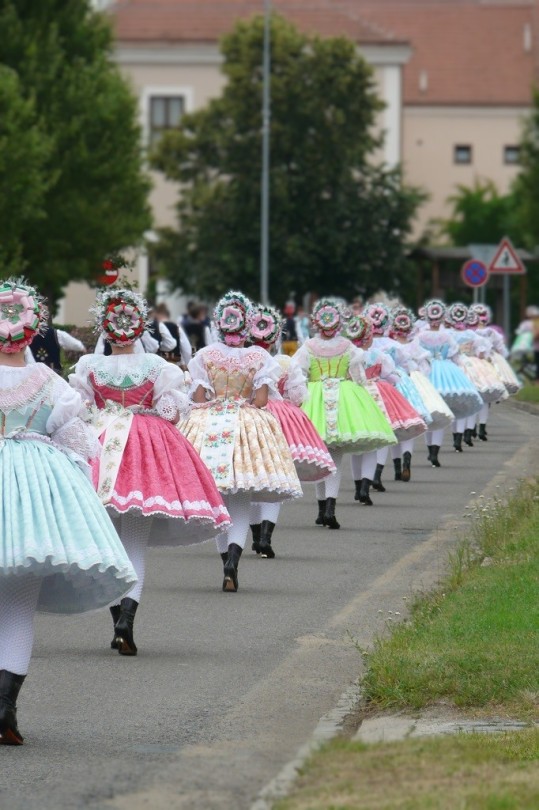

This place has wonderfully preserved their beautiful culture.

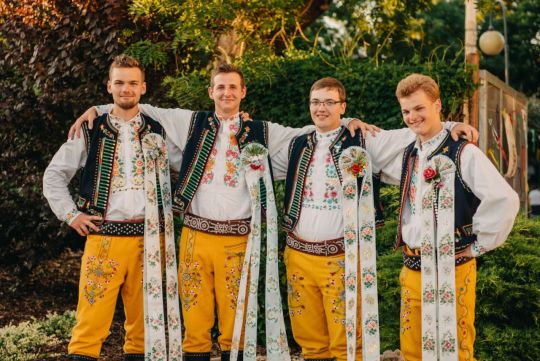
You will notice with Moravian dresses, women tend to have large, puffy dresses with their distinctive huge, wide skirts and abundant petticoats underneath.


In many regions in South Moravia, men's costumes typically include a long white embellished ribbon with a decorated cockade on the right side of their vests as you can see above.


I managed to find some older photos from 1959 too❤️

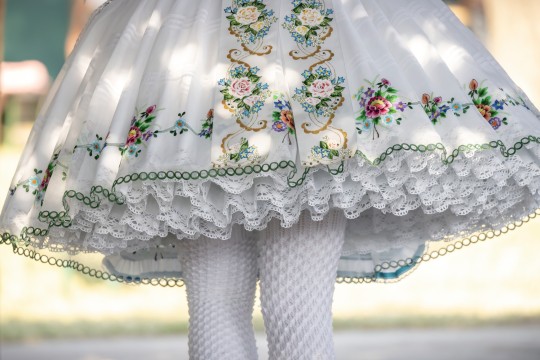
A traditional dress/costume in Czech & Slovak is called a "Kroj" (pronounced like kroi). I love how highly and beautifully embellished each garment is from here❤️
#slavic#slavic culture#folk#folklore#slavic tradition#tradition#czech republic#czechia#czech girl#moravia#czech folklore#czech tradition#moravian folklore#morava#moravian tradition#czech traditional dress#moravian dress
271 notes
·
View notes
Text
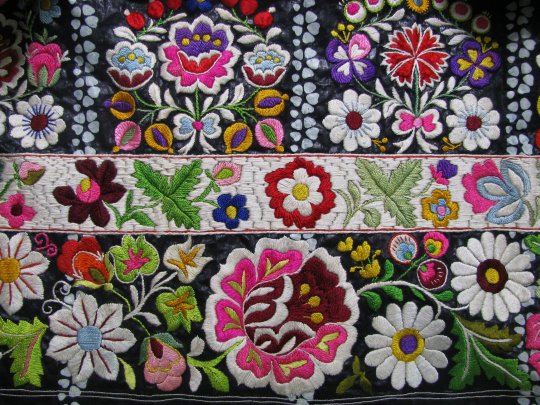
Author: Helene Cincebeaux
"Moravian Slovak wedding apron; satin stitch embroidery on batik chintz, made about 1920 possibly in Milotice near Kyjov.
My great aunt said it took a whole winter to make such an apron; she said they made a sketch on paper and then just started embroidering. Each one is a masterpiece made by village women who were true artists - bringing the flowers of their garden to bloom on their aprons all year long.
The white band is intricately embroidered and I love that nothing has to match - they just tossed in what felt right!"
#Folkways#Ancient Ways#Culture#Tradition#Slovak#Moravia#Moravian Slovak#wedding apron#satin stitch#embroidery#chintz#ca 1920#masterpiece#village women#art and soul#heart and soul#SymbolSpeak#AdoraFlora#flowers#blooms#apron#What is Remembered Lives
21 notes
·
View notes
Text

🐣 Did you know? that, by tradition, not visiting families (and thus not participating in mrskut) on Easter Monday can be considered a great offence to the family?
And if you come late, even a minute late after noon, expect a very cold shower from a vengeful lass. 🐣
Happy Easter (Monday)!!!
Tagging @noldorinpainter cuz 🤲💖 ngl it's us 🤣🤣🤣!!!
Refs/color palettes: 🇨🇿, 🇹🇷
#and here i am with my yearly easter monday czech/moravian traditions trivia 🤲🐣#the turkish gal was a mere visitor and wasn't pushed into the celebrations against her will 😅 i promise 🐣 tho if she wanted... 😅#also simplified embroidery and other stuff on both gals 😔 forgive me 🌼#non-arda stuff#easter#easter monday#slavic culture#turkic culture#moravian culture#hanakian culture#hanakian traditional clothing#central turkish traditional clothing#art#my art#joli's art#traditional art#digital art
16 notes
·
View notes
Text
My miniature Dožínky wreathe! Very happy with my first attempt. Part of today’s late equinox celebration.
@graveyarddirt I have to tag you because you’re my seasonal craft partner!
41 notes
·
View notes
Text
To follow up on my Hosanna poll, I think before things go any further, it'd be good to actually explain and define it. I was initially going to wait until the end of the poll, but it seems that google is giving people a lot of bad and/or conflicting answers and I'd rather people walk away with the correct information.
So! Hosanna is an anglicized version of the Hebrew words "hosha na" [הושע נא or as a contraction הושענא]. Hosha na is a little enigmatic and hard to translate, but the simplest translation is probably "save us, please." It's traditionally used as an exclamation to G-d to rescue us, but it also has shades of being a triumphant shout (the implication being confidence that G-d will save us.)
Jews say "hoshanot" (the plural of hosha na) as part of our traditional Sukkot liturgy, and is something we do still today.
For us, the multi-faceted meaning of the root word allows us to have multiple layers of meaning. During Sukkot, we start praying for rain in its proper season and amounts, and we shake the lulav and etrog as part of these processions and liturgy. On Hoshana Rabba [the "great hoshana"], the last day of Sukkot, we process around the bimah (front lectern) seven times as a completion of our season of repentance and our starting of the new year with abundant blessings.
My siddur (prayer book) Lev Shalem has this as an explanation and translation:



[Image ID is of the Lev Shalem siddur, pages 382 & 383 - I tried hard to find a pdf of this that would be readable using a screen reader, but the versions I'm finding cut off at pg. 376 at the latest. If anyone has bandwidth to type this up, I would greatly appreciate it]
For the curious, here is a recording of the Hoshanot liturgy and procession:
youtube
Christians mostly know the word from the gospels and hymns.
Here is what Wikipedia says about its use in Christianity:
Historical meaning
Since those welcoming Jesus were Jewish, as of course Jesus himself was, some would interpret the cry of "Hosanna" on the entry of Jesus in its proper meaning, as a cry by the people for salvation and rescue.
Christian reinterpretation
"Hosanna" many interpret as a shout of praise or adoration made in recognition of the messiahship of Jesus on his entry into Jerusalem
It is applied in numerous verses of the New Testament, including "Hosanna! blessed is the one who comes in the name of the Lᴏʀᴅ!" (Matthew 21:9,15; Mark 11:9–10; John 12:13), which forms part of the Sanctus prayer; "hosanna in the highest" (Mark 11.10); and "hosanna to the Son of David" (Matt 21:9). These quotations, however, are of words in the Jewish Psalm 118. Although not used in the book of Luke, the testimony of Jesus' entry into Jerusalem is recorded in Luke 19.
In church music
The "Hosanna Anthem", based on the phrase Hosanna, is a traditional Moravian Church anthem written by Bishop Christian Gregor of Herrnhut sung on Palm Sunday and the first Sunday of Advent. It is antiphonal, i.e. a call-and-response song; traditionally, it is sung between the children and adult congregation, though it is not unheard of for it to be done in other ways, such as between choir and congregation, or played between trombone choirs.
The bottom line:
Jews and Christians have different connections, associations, and meanings attached to this word as expressions of our different theologies and texts. The word is derived from a Hebrew word and was created by Jews and is still used by us today. (Like literally today - we are currently in the middle of the Sukkot festival.) Christians changed the meaning to fit within their own context, and pronunciation of the word evolved with linguistic drift over time. In the same way that there's not a reason to pitch a fit over saying Jesus rather than Yeshua, there's no compelling reason to change hosanna back to hosha na; if anything, the distinction helps make it clear that it's effectively a different word and concept from ours.
On the other hand, I do think Christians ought to know the original meaning of the word if they're going to use it. To only ever know their version when it was derived from ours is yet another small way of playing into supercessionism by erasing and replacing the Jewish context of things that were originated in Judaism that Christians have embedded in Christianity. While the Christians of today cannot unwind the supercessionism of Christian history, they *can* choose to understand their present Christianity in ways that do not play into supercessionism and that respect the Jewish community of today.
I hope this was helpful and gives folks a new perspective on an obscure Hebrew word!
472 notes
·
View notes
Text
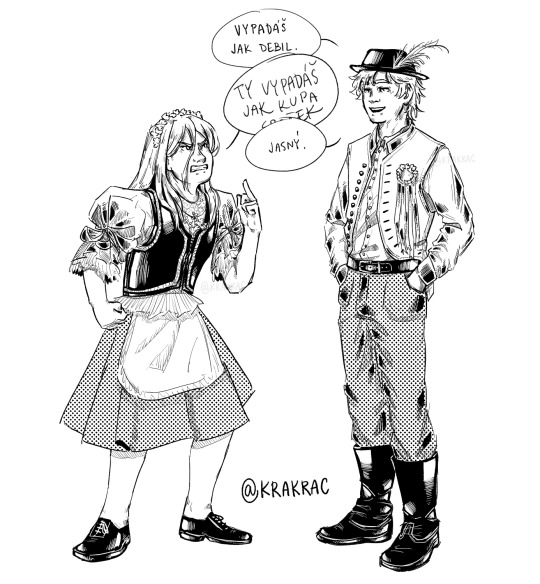
omg co dělají jirka běletský a anička běletská z hit vocaloid série párty jsou pro lúzry na moravských hodech???
translation below!
Yura: "You look like a moron."
Anya: "YOU LOOK LIKE A PILE OF SHI–"
Yura: "Right."
"omg what are yura beletsky and anya beletskaya from the hit vocaloid series parties are for losers doing on the moravian hody???"
to explain: hody are a kind of festivities in czechia and other slavic countries (idk how to translate properly lmao). the costumes yura and anya wear in this drawing are called kroje, kroj in singular, a traditional clothing, and i drew these to look very similar to those in my hometown!
#pafl#parties are for losers#pafl fanart#pafl yura#yura beletsky#yura#my art#art#fanart#anya#anya beletskaya#pafl anya#č
63 notes
·
View notes
Text
These southern cultures developed what anthropologists call a “culture of honor tradition” in which males treasure their honor and believed it can be diminished if an insult, slight or wrong were ignored. “In an honor culture you have to be vigilant about people impugning your reputation and part of that is to show that you can’t be pushed around,” says University of Illinois Urbana-Champaign psychologist Dov Cohen, who conducted a series of experiments with Nisbett demonstrating the persistence of these quick-to-insult characteristics in university students. White male students from the southern regions lashed out in anger at insults and slights that those from northern ones ignored or laughed off. “Arguments over pocket change or popsicles in these Southern cultures can result in people getting killed, but what’s at stake isn’t the popsicle, it’s personal honor.”
[...]
By contrast, the Yankee and Midland cultural legacies featured factors that dampened deadly violence by individuals. The Puritan founders of Yankeedom promoted self-doubt and self-restraint, and their Unitarian and Congregational spiritual descendants believed vengeance would not receive the approval of an all-knowing God (though there were plenty of loopholes permitting the mistreatment of indigenous people and others regarded as being outside the community.) This region was the center of the 19th-century death penalty reform movement, which began eliminating capital punishment for burglary, robbery, sodomy and other nonlethal crimes, and today none of the states it controls permit executions save New Hampshire, which hasn’t killed a person since 1939. The Midlands were founded by pacifist Quakers and attracted likeminded emigrants who set the cultural tone. “Mennonites, Amish, the Harmonists of Western Pennsylvania, the Moravians in Bethlehem and a lot of German Lutheran pietists came who were part of a tradition which sees violence as being completely incompatible with Christian fellowship,” says Joseph Slaughter, an assistant professor at Wesleyan University’s religion department who co-directs the school’s Center for the Study of Guns and Society.
74 notes
·
View notes
Text
Communication with the dead visiting the earth, i.e., communication with an earthly otherworld, appears in the beliefs concerning seers with mora traits and in the beliefs and even visions experienced by many active seers of the dead. The notion of initiation by the dead visiting the earth appears in many cultural forms. One of the most frequent variants occurs when the dead, returning in troops such as a gang of ghosts visiting around Christmas time or unbaptized souls, snatch a living person for a short period of time to show her or him who will be the dead of the coming year. These data fit into the traditional framework of communication with the "living dead" that were traditional all over Europe in the system of places and times related to the dead. Ever since the Christian Middle Ages, the returning dead have been known to visit the living periodically, at start-of-the-year or start-of-season festivals. The phenomenon of initiation by St. Lucy's chair occurs in this sphere at Christmas. Female initiating spirits from the world of the dead, sometimes with traits of the underworld, have also appeared from time to time as leaders of soul troops in a number of local variants in accordance with the local mythological legacy (such as the Austrian-German Perchta, Holda, the Swiss Frau Saelde, the Slovenian Pehtra baba, the Hungarian and Czech-Moravian Lucia, Luca, etc.), often displaying attributes to do with spinning and other womanly tasks, as well as with cows or milk.
Éva Pócs
11 notes
·
View notes
Text
THEOLOGY
ABRAHAMIC RELIGIONS ->
THE THREE MAJOR ABRAHAMIC RELIGIONS are, in order of appearance, JUDAISM, CHRISTIANITY, and ISLAM, but there are other MINOR RELIGIONS.

■JUDAISM is an Abrahamic monotheistic religion based on the covenant shared between God and Abraham.
The holy scriptures of JUDAISM are called the TANAKH, after the first letters of its three parts in the Jewish tradition. T: TORAH, the Teaching of Moses, the first five books. N: NEVI'IM, the books of the prophets. KH: KETUVIM, for the Writings, which include the psalms and literature for the wise.
ORTHODOX JUDAISM is the belief in a strict interpretation of Jewish law, which should be grounded in the Torah. As such, the revelation given to Moses from God on Mount Sinai is made glorious and just.
CONSERVATIVE JUDAISM is the belief in marriage and membership as a Jew. Other characteristics will include support of the Zionist movement and the rejection of the immutability of the "Torah" and the "Talmud" while still having faith in the eternal truth upon which it is based.
REFORM JUDAISM is the belief of the renewal in our living Covenant with God, the people of Israel, humankind, and the earth by acknowledging the holiness present throughout creation – in ourself, in each other, and in the world at large – through practice that will include reflection, study, worship, ritual, and much more.

■CHRISTIANITY is an Abrahamic monotheistic religion centered around the birth, life, death and resurrection of Jesus Christ.
THE BIBLE is the holy scripture of the Christian religion, purporting to tell the history of the Earth from its earliest creation to the spread of Christianity in the first century A.D. Both the Old Testament and the New Testament have undergone changes over the centuries.
□ROMAN CATHOLICISM
Roman catholicism is a branch of Christianity which has its belief about the sacraments, the role of the Bible and tradition, the importance of the Virgin Mary and the saints, and the papacy.
HISTORY OF THE REFORMATION
THE REFORMATION was a reform movement in religious belief that swept through Europe in the 16th century. It caused the creation of a branch of Christianity called PROTESTANTISM, a name used collectively to refer to the many religious groups that separated from the Roman Catholic Church due to their difference in doctrine.
□PROTESTANTISM
Protestantism is a branch of Christianity which will deny the universal authority of the Pope and affirm all of the Reformation principles of justification by faith alone, the priesthood available to any practitioner, and the Bible as the only source of revealed truth.
□QUAKERISM
Quakerism is a branch of Protestantism
Follow your "inner light"
The Bible
Equality for all
God is accessible to everyone
No clergy
No religious ceremonies
No sacraments
LOCATION -> England
WHEN -> 17th Century
Adventism
Anglicanism
Anabaptism
Baptism
Irvingianism
Lutheranism
Methodism
Moravianism
Pentecostalism
Waldensianism
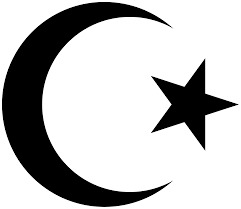
■ISLAM is an Abrahamic monotheistic religion that was revealed to Muhammad, a prophet of Allah, and written down in the Qur'an years later by his followers.
SUNNI
Muhammad did not specifically appoint a successor to lead the Ummah before his death. This sect did, however, approve of the private election of the first companion, Abū Bakr. In addition to the previous mentioned, Umar ibn al-Khaṭṭāb, ʿUthmān ibn ʿAffān, and ʿAlī ibn Abī Ṭālib are also accepted as al-Khulafāʾ ur-Rāshidūn. After this, they believe that Muhammad intended that the Muslim community choose a successor, or caliph, by consensus. A practitioner of this sect will base their religion on the Quran and the Sunnah as understood by the majority of the community under the structure of the four schools of thought. These are HANAFI, MALIKI, SHAFI'I and the HANBALI.
SHI'A
Muhammad's family, the Ahl al-Bayt, including all of his descendants, have distinguished spiritual and political authority over the community. It is believed that Alī ibn Abī Ṭālib was the first of these descendants and the rightful successor to Muhammad. As a result, it was rejected that the first three Rāshidūn caliphs have legitimacy.
------------------------------------------
ETHICAL RELIGIONS ->
THE THREE MAJOR ETHICAL RELIGIONS are BUDDHISM, TAOISM, AND CONFUCIANISM.

■BUDDHISM is an ethical religion that was revealed by Siddhartha Gautama for anyone to gain spiritual enlightenment if that person followed the eight-folded path along with a personal commitment to any noble truth given to him/her through the journey of life in order to reach nirvana.

■TAOISM
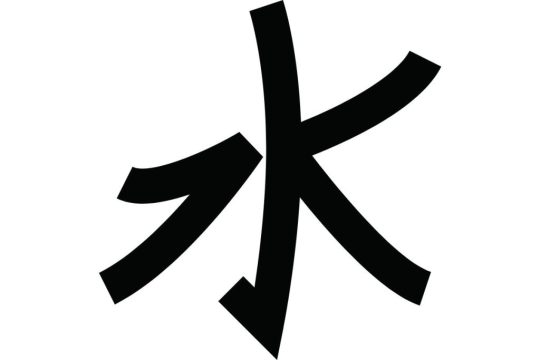
■CONFUCIANISM
15 notes
·
View notes
Note
I absolutely adore your art of the Nohr siblings you have such a beautiful and expressive style! In some of them like the farm piece they seem to be wearing more traditional outfits out of curiosity have you based them on any specific culture? They're beautiful and they remind me a lot of both my Moravian and Ukrainian side of the family's traditional costumes.
Thank you a lot!
I usually mix several countries and make up stuff myself since they don't belong to a real country. The designs I have drawn the most borrow heavily from Norwegian outfits in particular.
For the farm pic I tried to do indistinct folk outfits. For example even most of the references are from Northern Europe, Camilla's shirt is fully Spanish.
I do have some pictures saved from Ukrainian traditional costumes too, they are beautiful.
26 notes
·
View notes
Text
Please reblog for a bigger sample size!
If you have any fun fact about Moravia, please tell us and I'll reblog it!
Be respectful in your comments. You can criticize a government without offending its people.
5 notes
·
View notes
Text

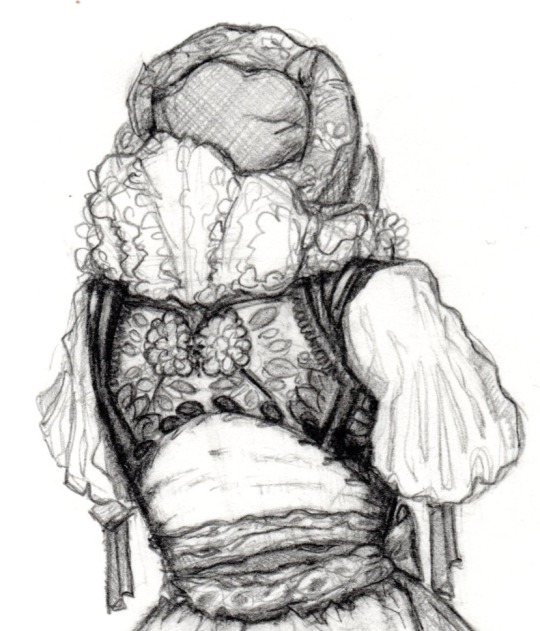

Ngl this should've come out three days ago... so... happy Czechoslovalloween 🎃🎃🎃 bafiki-baf!!!
References here: 🇨🇿, 🇸🇰
#i'd go trick-or-treating as a hanakian klekánica no hesitation 😘😘😘#liberties ofc taken... 😅🌟#non-arda stuff#slavblr#slavic culture#moravian culture#slovak culture#haná#spiš#traditional clothing#art#traditional art#pencil art#joli's art
4 notes
·
View notes
Text
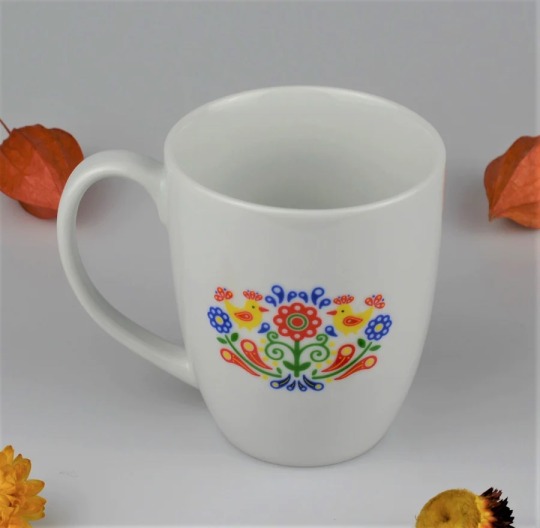



Porcelain cups with Moravian decorative motifs.
23 notes
·
View notes
Text
Europa Nostra - Most Endangered in 2023
On the occasion of the 10th anniversary of the 7 Most Endangered Programme in 2023, Europa Nostra – the European Voice of Civil Society Committed to Cultural and Natural Heritage – and the European Investment Bank Institute have just announced the 11 most threatened heritage sites in Europe shortlisted for this year’s edition of the programme.

Among 11 most endangered monuments and heritage sites in Europe for 2023 are Kortrijk Railway Station (Belgium), Domain and Royal Museum of Mariemont in Moralwez (Belgium), Tchakcinij Fortress in Zugdidi (Georgia), Sister's House Ensemble - former Moravian settlement in Kleinwelka (Germany), Mansion Konaki of Gidas in Alexandria (Greece), Herman Otto Museum in Miskolc (Hungary), Memento Park in Budapest (Hungary), Cultural Landscape of Paštrovska Gora (Montenegro), Cultural Landscape of Sveti Štefan in Paštroviči (Montenegro), Watermills of Bistrica in Petrovac na Mlavi (Serbia), and the Partisan Memorial Cemetery in Mostar (Bosnia and Herzegovina) designed by Bogdan Bogdanović.

A view from the top of the cemetery before the latest conflicts.
The selection was made on the basis of the outstanding heritage significance and cultural value of each of the sites as well as on the basis of the serious danger that they are facing today. The level of engagement of local communities and the commitment of public and private stakeholders to saving these sites were considered as crucial added values. Another selection criterion was the potential of these sites to act as a catalyst for sustainable development and as a tool for promoting peace and dialogue within their localities and wider regions.

A view on the central fountain at the top of the site.

A sketch showing the path of the water flow.
The 11 endangered heritage sites were shortlisted by an international Advisory Panel, comprising experts in history, archaeology, architecture, conservation, project analysis and finance. Nominations for the 7 Most Endangered Programme 2023 were submitted by member organisations, associate organisations or individual members of Europa Nostra from all over Europe as well as by members of the European Heritage Alliance. For the Partisan Monument in Mostar a support was given among others also by Architectuul and DESSA Gallery from Ljubljana.
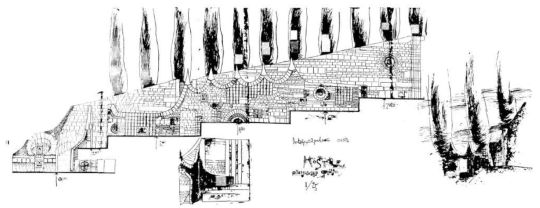
A cross-section of the cemetery and its terraces.
The Partisan Memorial Cemetery was built in 1965 in the town of Mostar. It is one of the largest anti-fascist monuments and sites in the Balkans, with its 300-metre-long paved ceremonial pathway rising more than 20 metres up a hill. The cemetery, which features some 700 individual tombstones as grave markers of freedom fighters from the Yugoslav Partisan movement, is part of a series of monuments and sites built in the region in memory of the partisans who died during World War II.
It was designed by the famous Yugoslav architect Professor Bogdan Bogdanović from Belgrade. Skilled stonemasons built the monument over several years, using over 12,000 carved limestone pieces, rubble from the town’s destruction during the war, and traditional stone roof tiles recycled from Mostar houses. The monument was inaugurated in 1965 by the President of Yugoslavia, Josip Broz Tito, on the occasion of the 20th anniversary of the liberation of Mostar from the Nazis and their local allies in 1945.
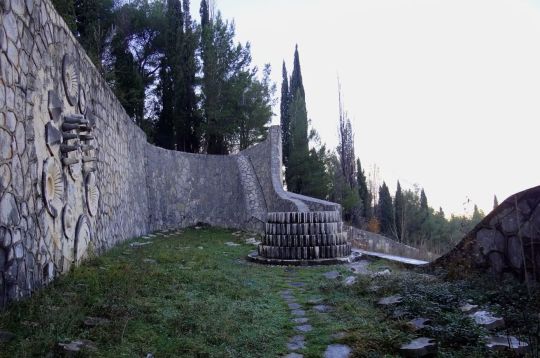
In front of the portal lies an a-centrically located gear-shaped fountain which used to develop a water stream that flowed down the terraces and emerged again in the dead end space at the bottom of the complex.
The Partisan Memorial Cemetery – with its memorial significance and relevance – has become a target for destruction, both in times of war and in times of peace. Although much damaged during the war in 1992-1995, the Partisan Memorial Cemetery suffered further damage in the period following the war. It is important to add that after the violent disintegration of Yugoslavia, many memorial sites built after World War II were neglected or even abandoned in the wider region, including the Partisan Memorial Cemetery in Mostar.
After the war, the first conservation and restoration works on the Partisan Memorial Cemetery were done in 2005 with the support of donor funds from the Government of The Netherlands and the Kingdom of Norway, and with co-financing from the City of Mostar and Federation of Bosnia and Herzegovina.
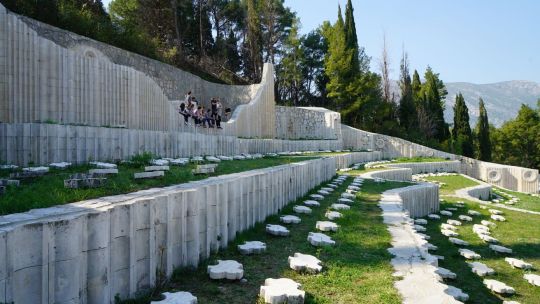
The complex is a necropolis, 630 abstractly shaped stone markers testify the multiethnic army that fought together and is buried here with names belonging to Serbs, Croats, Bosniaks, Jews.
However, the Partisan Memorial Cemetery has been, and still is, one of the region’s contested heritage sites. This has resulted in repeated acts of vandalism up until the most recent destruction which happened in June of 2022. This was followed by numerous reactions from the Mayor, the City Council, the Commission to preserve national monuments of Bosnia and Herzegovina, as well as from anti-fascist activists and associations both at local and international level, and also the reaction from numerous organisations from the territory of former Yugoslavia, which condemned the vandalism of the Partisan Memorial Cemetery. Recently, the Agency “Old City” of the City of Mostar launched the public procurement for the revitalisation, rehabilitation and illumination of the Partisan Memorial Cemetery. However, the monument does not yet have a holistic plan for its conservation and maintenance with a corresponding funding. The whole process of its necessary restoration and revitalisation therefore remains precarious.
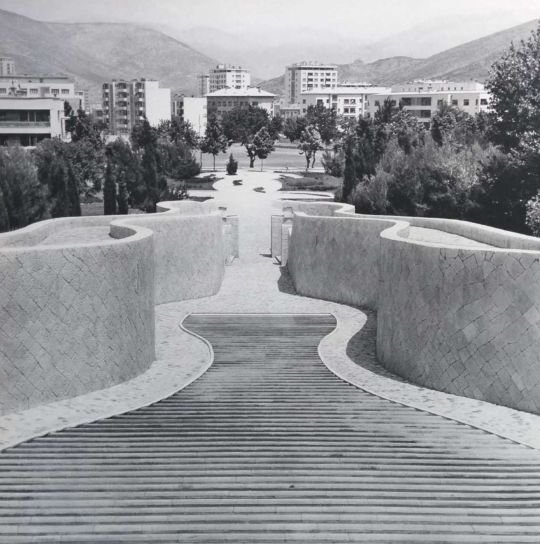
The partisan cemetery in Mostar is an integral part of the city and can be easily considered as an urban place.
The local community in Mostar has developed various campaigns for the legal protection of the Partisan Memorial Cemetery as a Monument of National Importance. Among other initiatives, they produced a documentary about the history of this memorial site and the threats and challenges it faces today.
The nomination of the cemetery to the 7 Most Endangered Programme 2023 was made by IDEAA Mostar with the endorsement of the Mayor of Mostar, the Galerija DESSA, Arcihtectuul and Europa Nostra Serbia. The nominator advocates for adequate legal protection of the Partisan Memorial Cemetery following its designation as a Monument of National Importance back in January 2006, for the European and international recognition of its outstanding historical and artistic values, as well as for the development of a sustainable rehabilitation, maintenance and management plan for this exceptional memorial site and the allocation of necessary funds – from local, national and European sources – for the quality implementation of such a comprehensive plan.
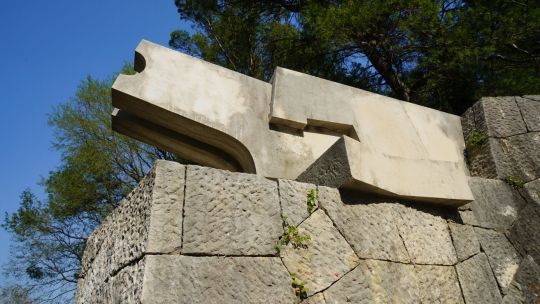
An abstract lion sculpture at the entrance of the complex.
The Advisory Panel of the 7 Most Endangered Programme commented: “The original design of the Partisan Memorial Cemetery in Mostar deliberately avoids the use of political or religious symbolism but makes use of cosmological symbols reminiscent of pre-Columbian remains and perhaps also referencing similar elements present in medieval sites in Bosnia and Herzegovina. As such, it is an outstanding example of the high-quality commemorative culture rooted in anti-fascist ideals within SFR Yugoslavia. At the time when Europe seeks to assert and put a much stronger emphasis on the vital importance of the shared values which form the very basis of the entire European project, this significant place of memory located in the Western Balkans should be restored with the support of local, national and European funds and protected for present and future generations.”

On Wednesday, June 15, 2022, vandals carefully and cold-bloodedly destroyed all the commemorative plaques.
The Executive President of Europa Nostra, Prof. Dr. Hermann Parzinger, stated: “This shortlist covers a wide variety of monuments and heritage sites which are facing different types of serious threats. The local communities and civil society organisations are deeply committed to preserving these remarkable examples of our shared heritage, but they need broader support. We therefore call on local, regional, national and European stakeholders, both public and private, to join forces with Europa Nostra and our network of members and partners to secure a viable future for these shortlisted sites.”

The "cosmic portal" is centrally located on the wall that backs the uppermost terrace. This circular element seems to act as a door between the two worlds and tries to reconcile the different visions that various religions have developed about the afterlife.
The final list of 7 Most Endangered heritage sites in Europe for 2023 will be unveiled in April.
21 notes
·
View notes
Text
16^12 Angora Civs "Roadmap" (0x12/?)



Welcome to the 16^12 referee guide...
Civilizations / cultures
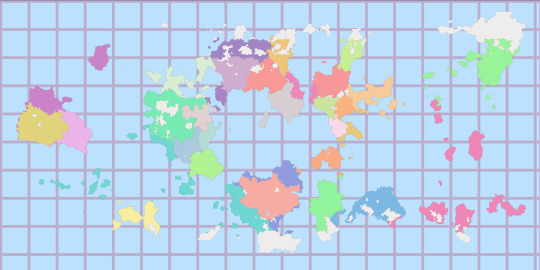

Starting point in Azgaar (From their maximum of 32 vanilla cultures at once...) [Super, Major, Minor tier ranks for Civ & City-States prioritization for Civ 5 scenarios-sake]
Utchewn (Shoshone Super Civ, Moson Kahni)
Marsch (Austria Major Civ, Wien)
Chunhau (Yue / Cantonese? Minor Civ, Guangzhou)
Samas (Samoa Super Civ, Apia)
Talyian (Persian Iran Major Civ, Persepolis)
Cao (Vietnam Super Civ, Hanoi)
Hwatcha (Korea Super Civ, Seoul)
May (Mayas Super Civ, Palenque)
Eqalen (Inuit Super Civ, Ivvavik)
Matwa (Swahili / Carib? Major Civ, Zanzibar)
Zebie (Carthage Super Civ, Carthage)
Mersuit (Sweden Major Civ, Stockholm)
Hugues (Scotland Major Civ, Edinburgh)
Aberku (Aremorici Super Civ, Darioritum)
Eyn (Sumer Major Civ, Ur)
Tabar (Morocco Super Civ, Marrakesh)
Tersun (Poland Super Civ, Warsaw)
Ibrad (Huron / Blackfoot / Basque? Major Civ, Ossossane)
Temu (Angola Super Civ, Luanda)
Sasson (Burgundy Major Civ, Dijon)
Treano (Italian / Netherlands Major Civ, Amsterdam)
Ishtar (Babylon Major Civ, Babylon)
Turchian (Turks? Major Civ, Edirne)
Medran (Spain Major Civ, Toledo)
Arela (Portugal Major Civ, Lisbon)
Hangzhou (Manchu? Minor Civ, Shenyang)
Palche (Incas Major Civ, Cusco)
Mangapu (Indonesia / Indian? Minor Civ, Jakarta)
Rzhev (Czech / Moravian / Slavic? Minor Civ, Prague)
Troporea (Minoans Major Civ, Knossos)
Lueur (Nubia / Mongolia? Minor Civ, Meroe)
Syrus (Assyria Super Civ, Ashur)
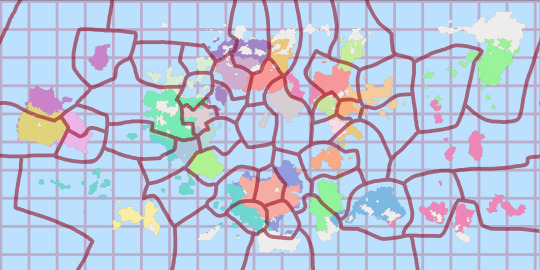
To the 48 cultures excluding the future's otherkin sapient clades...
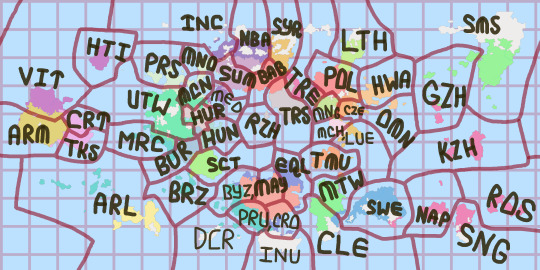
Hittites (Hattusa, Minor)
Byzantium (Constantinople, Minor)
Brazil (Rio de Janeiro, Minor)
Hungary (Budapest, Minor)
Myceneans (Mycenae, Minor)
Argentina (Buenos Aires, Minor)
Dene / Cree (Mikisiw-Wacihk, Minor)
Croatia (Zagreb, Minor)
Prussia (Konigsberg, Minor)
Hanseatic League / Mecklenburg (Rostock, Minor)
Chile (Santiago, Minor)
Kazakhs (Almaty, Minor)
Lithuania (Vilnius, Minor)
Two Sicilies (Naples, Minor)
Oman (Muscat, Minor)
Songhay (Songhai, Minor)
Just noting down that the map fully wraps around the X-axis, like a globe. ;-)
Religions
Pohakantenna (Shoshoni pantheon, quirky thanks to their "Daughters of Utchwendira" communion with the divine)
Angakkunngurniq (Inuit pantheon)
Confucianism / Shinto tradition?
Al-Asnam (serving as Aremorica's Celtic druidic-like pantheon over there, inspired by the classical era Galatians)
Ba'hai (monotheistic non-exclusive syncretism)
Arianism (iterated from the defunct Christianity dialect)
Chaldeanism (Mesopotamian pantheon)
Calvinism (derived from the Protestant Reformation’s Huguenot Southern French, monotheism)
Tala-e-Fonua (Samoan pantheon)
Hussitism (central slavic dialect of monotheism)
Jainism (communal humility & individualized Ki monks culture)
Buddhism (inner way reincarnation & large monasteries)
Judaism (the theological foundation of which most of the monotheistic faiths in this world agree upon nowadays)
Zoroastrianism (Iranian religion)
Ibadiyya (their Ba'hai like Islam is a very minor religion with a outsized impact here, just like Judaism is in our world)
Canaanism (Carthaginian belief system)
Pesedjet (Numidan Hieroglyphics belief system)
Mwari (Carib religion)
Intiism (Inca pantheon)
Tzolk'in (Mayan pantheon)
Have a great day ppl!
4 notes
·
View notes
Text

This illustration is labeled "Peruchty. perychty, peruty na Podřipsku," Figure 21 in a book on Czech festivals by Zíbrt, Čeněk. Veselé chvíle v životě lidu českého. Czechia: Nákl. F. Šimačka, 1910.
"The bahby are coming!"
Czech guisers as old women carrying brooms during the Winternights festival, between Christmas and Feast of the Epiphany. Here the pagan and christian customs syncretize and converge, with masked processions, songs, rites, and play. Past posts discuss the Perchten who are active in southern German-speaking regions, especially Austria, with masks of the Old Goddess Perchta, races, and masquerades. The Czechs had their version of this celebration, with a variety of names for the (sometimes demonized) goddess [ch prounounced kh, not like in "choice"]:
"Perchta, Perechta, Peruchta, Parychta, Šperechta. Mainly South Bohemian folklore today knows Perechta as a mare, made of linen, a klibna (see next), which goes around the buildings at Christmas and Shrove Tuesday. The North Bohemian and Moravian folk tradition has preserved under the name Perechty, Šperechty the image of a female monster who goes around and threatens women who pass on Thursdays, children who do not fast or are naughty. Thus we distinguish Perechty (Peruchty), monstrous figures, prowling and haunting, and Perechty, masqueraders disguised as mares.
Čeněk gives detailed description of the varying customs and costumes, masks and rites, in different locales of Czechia. Often a chalice or goblet was carried, or very commonly brooms, which masqueraders used to sweep out rooms in the houses they visit (and demand pastries, food, and drink from), also sweeping benches, tables, shelves, stoves. Sometimes they swept the stove, in order to remove malign and impure influences for the coming year. All the while they are singing about baking, brewing, and goose in the oven. Or the procession carries brewers' vessels, malt, mixing bowls, and sometimes plasters the walls using their brooms.
"In Western Europe, especially among the Germans, the Feast of the Three Kings (Berchtentag) was personified as the supernatural being Berchta, Perchta, who is also known to the Slavs and neighboring Germans. [Omitting embedded footnotes, for which see link.] Peruta, Parychta, in Moravia Šperechta, near Slovenia Pehtra baba, Vehtra baba.
...
"In 1861, W. Wattenbach found a manuscript from the 15th century in the castle library in Fulnek in Moravia (from 1418) a guide to writing letters, compiled in Jihlava by an unknown schoolmaster, called »Candela rhetoricae«... [He refers to] the parable of the ghostly Perchta, who is said to have a golden head, pewter eyes, copper ears, an iron nose, a silver beard (moustache?) and a leaden neck.) [This concurs with German traditions recorded by Jacob Grimm in the early 19th century, of "Percht with the Iron Nose," who is also long-toothed, like the Baba Yaga, and often her teeth are also iron.
...
"It can be seen how the name Perchta generalized in the folk tradition at that time and was added to the folk tradition.+) >She walks like Perchta, Paryta«, i.e. proudly, about a strong, stout, haughty woman, but sometimes also taken in the sense of dejected, mournfully flabby...
...
"In German mythology, the name originally sounded like this in Old German Perahta, later it was softened into Berchta, Bertha. Its proper meaning was: 'Shining, great, noble, graceful.' This fabulous being, similar or quite identical to Frau Holda, occurs precisely in the Upper German countries where she (Holda) stops, namely in Swabia, Alsace, Switzerland, Bavaria and Austria; part of the Franks and Durinci know Perchta and Holda side by side, at least there are boundaries between the two.)
"According to the meaning of the word, Perchtha was originally a benevolent, joy-bringing goddess; but it is rarely presented as such, usually the horrible nature is pointed out. [In other words, she became demonized] She acts as a scary character and a bully scaring children. In fairy tales about Perchta, the bad meaning prevails, as well as the good meaning about Holda.
"Their identity can also be seen from, among other things, the fact that they both circumambulate the twelve days between Christmas, with which in the beginning of the Middle Ages the Christian New Year began in some places, and the Feast of the Epiphany, but for Percht among the Germans there is a special day at the end of this period, the day Perchtin (Perchtag, Percht-abend) established.
"Perchta, like Holda (according to German legends), watches over ancestors or laundresses [also newborns, especially unbaptized ones], and whatever she finds unspun on the last day of the year, she spoils it. [Since the Old Goddess ruled spinning , custom decreed that the last of the flax or wool be spun off before her holyday, or else. The following tradition is probably an adaptation of Christian fasting customs:]
"According to ancient custom, her celebration must be celebrated with porridge and fish. Anyone who has eaten other foods on her day will have their stomach cut open, filled with chopped meat [or straw, according to Grimm] and sewn up again with a hoe instead of a needle and a chain instead of threads. That's why in Moravia, somewhere on Christmas Day, they [the Perahty masqueraders] haunt children, if they don't observe the fast and eat something before dinner, by beating them.
...
2 notes
·
View notes